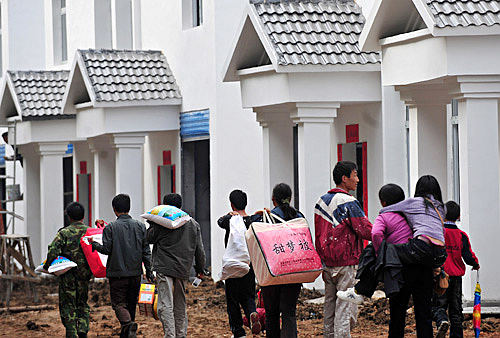|
 |
|
HOME SWEET HOME: Villagers from Laojundian Village near Danjiangkou, Hubei Province, are moving to their new homes. All 429 residents from the village will be relocated for construction of the South-to-North Water Diversion Project (HAO TONGQIAN) |
Three months ago, Huang Chaohai and his family were relocated 140 km from their home in Miaowan Village near Danjiangkou, Hubei Province, to Laolijia Village. Soon, the 46-year-old farmer's old home will be completely submerged, consumed by flood waters after the Danjiangkou Reservoir dam is heightened as part of the South-to-North Water Diversion Project. Gone will be Huang's residence of 20 years and anything tangible of his life in Danjiangkou. And Huang couldn't be happier.
Huang's former home was located in mountainous terrain with poor transport facilities. The single-story house built more than two decades ago was starting to resemble a run-down shack as opposed to a suitable place for a family of four to live in.
Now, in the outskirts of Xiangfan City, Huang has found renewed happiness—and a brand new two-story house to call home. On the first floor of his new Laolijia Village home is a sitting room and kitchen, and the second floor boasts three bedrooms.
The new houses for relocated villagers were built by the government, Huang said. Designs for the houses were selected by migrants themselves from a series of government-approved blueprints. During construction, villager representatives came to supervise the quality of the houses as they took shape.
All 41 families from Miaowan Village have since moved to Laolijia Village.
But a new home is not all Huang has been blessed with. After the move, Huang was given 10 hectares of land under a special contract to grow wheat. And after reaping the harvest from the current wheat season, he plans to sow corn.
The land can produce three crops a year, Huang said, and he estimated his family's net income this year would exceed 50,000 yuan ($7,321). Last year, Huang's family earned 30,000 yuan ($4,392). Growing opportunities like this were nonexistent in Miaowan, where fields were sparse but hills plentiful.
Not all relocated residents, however, are as satisfied with their new living conditions. Zheng Jiazhong's heart and mind remain with his native village.
"The water quality in my old home is better than the water here," he said.
The 62-year-old Zheng lives alone—his wife passed away years ago—and his four sons all work in Shiyan, a city relatively close to his old home. But having relocated to Laolijia Village, his sons and grandsons cannot visit him often because of the extended journey. As the lone occupant in his new 170-square-meter house, Zheng feels the house is empty and void of life.
While opinions on the movement program vary, the water diversion project will provide great benefits for relocated individuals and the nation as a whole.
Relocating
Danjiangkou Reservoir, found near Miaowan Village, was built in 1973 for flood control, power generation and irrigation.
To address water shortages in north China, the Chinese Government decided to divert water from the Yangtze River to north China, selecting the reservoir as a water source for the middle route of the project.
| 